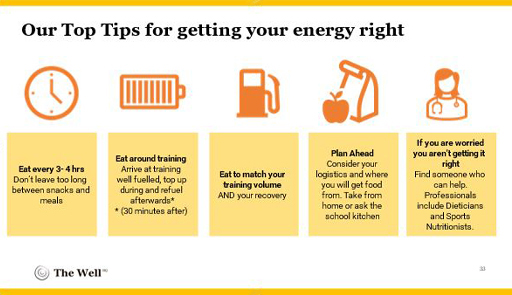6 Preventing RED-S in female athletes
RED-S can be prevented by maintaining energy balance where energy intake matches the energy demands of health, training, recovery, and everything else in an athlete’s life, which might include their job, studies and socialising. Figure 3 gives 5 top tips for getting the correct energy balance.
How can a coach support their female athlete?
A healthy athlete is more successful than a broken one
Telling an athlete to ‘eat more’ simply won’t work as it’s about changing behaviour, and sometimes addressing the athlete’s dysfunctional or emotional relationships with food.
As a coach you can ‘celebrate the power of food’. In conversations with athletes you can talk about the power of food as a fuel for performance. You can use coachable moments at the beginning of the session to ensure everyone has arrived well fuelled by asking ‘what did everyone have to fuel up for today’ and again at the end of the session ‘what is everyone going to eat to refuel’.
Use education to teach athletes about what and how to eat. While eating may seem intuitive, eating to fuel sports performance often isn’t and many athletes get it wrong. For example, the timing of energy delivery is just as important as the number of calories consumed. Ensuring that eating matches training volume and that athletes are not training without a pre-training meal or during fasting is important, as is remembering to eat soon after training.
Finally, ensure that athletes stop attaching value to body shape and size. This happens when an athlete looks at another athlete and believes their performance success is directly related to their leanness or believing that leanness will offer them a competitive advantage. It is important to understand that an under fuelled athlete, whilst being lean, is at a competitive disadvantage due to their shortage of energy.
Remarks that a coach or athlete may make, sometimes unconsciously, can serve to fuel a dangerous culture of restricted eating in sport. Athletes come in all shapes and sizes, success isn’t simply down to body size, and a healthy athlete is more successful than a broken one.

